Composite Geomembrane for Landfill Lining
Landfills play a crucial role in modern waste management, but their operation presents significant environmental challenges. The effective containment of leachate and gases is essential to prevent soil and water contamination. Composite geomembranes have emerged as an advanced solution for landfill lining, combining multiple layers to enhance performance and durability.
What is a Composite Geomembrane?
A composite geomembrane is a high-performance liner system made by combining different geosynthetic materials, typically a geomembrane and a geotextile. This multi-layered approach aims to leverage the strengths of each material, providing superior protection against leakage and damage. The geomembrane, often made from HDPE (High-Density Polyethylene) or LLDPE (Linear Low-Density Polyethylene), acts as a primary barrier, while the geotextile provides reinforcement and filtration.

Applications in Landfill Lining
New Landfills: In newly constructed landfills, composite geomembranes are used as a primary liner to prevent leachate from seeping into the surrounding soil. This initial layer is crucial for maintaining environmental integrity and complying with regulations.
Landfill Remediation: For existing landfills, composite geomembranes can be employed to upgrade or repair aging liners. Their application helps to address and mitigate any potential environmental hazards posed by older, deteriorating systems.
Waste Containment: Composite geomembranes are also used in various waste containment applications, such as hazardous waste sites and mining operations, where they provide essential protection against leakage and contamination.
Key Features and Benefits
Composite geomembranes offer several key benefits for landfill lining, making them a preferred choice for environmental protection and durability.
Enhanced Barrier Performance: Composite geomembranes typically consist of a geomembrane layer (such as HDPE or LLDPE) combined with a geotextile layer. The geomembrane acts as a primary barrier to prevent leachate from escaping into the soil and groundwater. The geotextile layer provides additional reinforcement and helps to distribute mechanical stresses evenly across the liner, reducing the risk of punctures and tears. For instance, in a study conducted by the Geosynthetic Research Institute, composite geomembranes demonstrated a significant reduction in leakage rates compared to single-layer geomembranes, with reductions in permeability reaching up to 99%.
Durability and Longevity: The durability of composite geomembranes is critical in the harsh conditions of a landfill. These geomembranes are designed to withstand physical damage, UV radiation, and chemical degradation. In a real-world case, a landfill in California used composite geomembranes in its lining system. The geomembranes performed well over a 20-year period, with minimal degradation observed. This long-term performance is attributed to the high-quality materials and the added protection of the geotextile layer, which helps to prevent mechanical damage to the geomembrane.
Ease of Installation: Composite geomembranes are often supplied in large, prefabricated sheets, which simplifies the installation process and ensures a seamless application. This reduces the risk of leaks and gaps that can occur with smaller, piecemeal installations. A landfill project in Texas utilized composite geomembranes and reported a 30% reduction in installation time compared to traditional methods. The large sheets allowed for quicker deployment and fewer seams, leading to a more reliable and efficient installation process.
Cost-Effectiveness: While the initial cost of composite geomembranes may be higher than single-layer geomembranes, their long-term benefits make them a cost-effective solution. The extended lifespan, reduced maintenance needs, and improved environmental protection contribute to overall cost savings. For example, a landfill in New York City invested in composite geomembranes for its expansion project. Over a 15-year period, the landfill experienced significantly lower maintenance costs and fewer environmental compliance issues compared to previous projects that used less durable liner materials.
Environmental Protection: Composite geomembranes play a crucial role in preventing soil and groundwater contamination by effectively containing leachate and gas emissions. This aligns with regulatory requirements and sustainability goals. A case study from a landfill in Germany highlighted the effectiveness of composite geomembranes in controlling leachate and gas emissions, leading to compliance with stringent environmental regulations and a positive impact on local water quality.
In summary, the key benefits of composite geomembranes for landfill lining include enhanced barrier performance, durability, ease of installation, cost-effectiveness, and environmental protection. These advantages make them a reliable choice for managing landfill leachate and ensuring long-term environmental safety.
Composite vs. Single-Layer Geomembranes
While single-layer geomembranes can offer adequate protection, composite geomembranes provide additional benefits through their layered structure. The combination of a geomembrane and geotextile enhances overall performance by addressing both permeability and mechanical strength. This dual-layer approach also improves resistance to punctures and tears, which is particularly beneficial in high-stress environments like landfills.
Composite geomembranes and single-layer geomembranes each have their own set of advantages and considerations. Understanding these differences can help in making informed decisions for landfill lining projects.
Performance Comparison: Composite geomembranes generally outperform single-layer geomembranes in several key areas:
Leakage Control: The combination of a geomembrane with a geotextile layer in composite geomembranes enhances leakage control. The geotextile layer helps distribute stress and reduces the likelihood of punctures, which can compromise the integrity of the geomembrane. Studies have shown that composite geomembranes exhibit lower leakage rates compared to single-layer geomembranes. For example, a comparison study published in the Journal of Geotechnical and Geoenvironmental Engineering found that composite geomembranes had a leakage rate reduction of up to 90% compared to single-layer HDPE geomembranes.
Mechanical Strength: The addition of a geotextile layer provides additional mechanical strength and resistance to punctures and tears. This is particularly important in landfill applications where the liner is subjected to significant stress from waste and construction activities. In a practical application, a landfill in Japan using composite geomembranes experienced fewer incidents of liner damage and improved overall performance compared to a similar landfill using single-layer geomembranes.
Cost Comparison: While composite geomembranes generally have a higher initial cost compared to single-layer geomembranes, they offer several long-term cost benefits:
Reduced Maintenance Costs: The enhanced durability and resistance to damage provided by composite geomembranes result in lower maintenance and repair costs over time. A landfill project in Australia that switched from single-layer to composite geomembranes reported a 40% reduction in maintenance costs over a 10-year period, attributed to the improved performance and longevity of the composite system.
Extended Service Life: Composite geomembranes typically have a longer service life compared to single-layer geomembranes. This extended lifespan reduces the frequency of liner replacements, leading to overall cost savings. For instance, a landfill in the UK that utilized composite geomembranes reported an increase in service life by 15 years compared to previous projects with single-layer geomembranes.
Case Studies: Real-world examples highlight the performance and cost differences between composite and single-layer geomembranes:
Case Study 1: A landfill in Brazil used single-layer geomembranes initially but faced issues with leaks and repairs. The facility transitioned to composite geomembranes and saw a dramatic improvement in leak prevention and reduced repair needs, resulting in long-term cost savings.
Case Study 2: An industrial waste site in South Korea compared the costs and performance of composite and single-layer geomembranes. The study concluded that while composite geomembranes had a higher upfront cost, their superior performance and lower maintenance requirements justified the investment.
In conclusion, composite geomembranes generally offer superior performance and long-term cost benefits compared to single-layer geomembranes. The enhanced leakage control, mechanical strength, and extended service life make them a valuable investment for landfill lining projects.
Environmental and Regulatory
When selecting composite geomembranes for landfill lining, it is crucial to consider environmental and regulatory factors to ensure compliance and protect natural resources.
Environmental Impact: Composite geomembranes play a significant role in minimizing environmental impact by providing effective containment of leachate and gas emissions. This helps prevent soil and groundwater contamination, which is critical in landfill operations. Environmental studies, such as those conducted by the Environmental Protection Agency (EPA), have shown that composite geomembranes significantly reduce the risk of leachate migration and gas emissions compared to traditional liner systems. A case study from a landfill in Sweden demonstrated that the use of composite geomembranes resulted in a 50% reduction in leachate contamination levels over a 10-year period.
Regulatory Compliance: Regulatory agencies often have strict requirements for landfill liners to ensure environmental protection and public health. Composite geomembranes are frequently used to meet these requirements due to their superior performance. In the United States, the EPA's Subtitle D regulations for municipal solid waste landfills mandate the use of composite liners to prevent leachate migration. Compliance with these regulations is essential for obtaining permits and operating landfills. A landfill in Ohio successfully met EPA requirements by using composite geomembranes, ensuring compliance and avoiding potential fines.
Sustainability Considerations: The use of composite geomembranes aligns with sustainability goals by reducing the environmental footprint of landfills. Many composite geomembranes are manufactured from recyclable materials, and advancements in technology are leading to the development of more sustainable options. For example, a landfill in Canada implemented a recycling program for geomembrane materials, contributing to a circular economy and reducing waste.
Case Studies and Success Stories:
Case Study 1: A landfill in the Netherlands adopted composite geomembranes as part of its efforts to meet stringent environmental regulations. The composite liners provided effective leachate and gas containment, leading to successful regulatory inspections and improved environmental performance.
Case Study 2: An industrial landfill in France utilized composite geomembranes to address soil and groundwater contamination issues. The implementation of composite liners resulted in significant improvements in environmental quality and compliance with local regulations.
In summary, composite geomembranes offer significant environmental and regulatory advantages by providing effective containment, ensuring regulatory compliance, and supporting sustainability goals. Their use in landfill lining projects helps protect natural resources and aligns with best practices for environmental stewardship.

Long-term Stability and Safety
Composite geomembranes play a crucial role in ensuring long-term stability and safety in landfill operations through their robust physical properties and effective containment capabilities.
Enhanced Containment Capabilities: Composite geomembranes are designed to provide a dual-layer protection system, combining the impermeability of a geomembrane with the reinforcement of a geotextile layer. This combination ensures that leachate and gas emissions are effectively contained, minimizing the risk of environmental contamination. In a study conducted by the Geosynthetics International Journal, composite geomembranes were found to significantly reduce leachate leakage rates by up to 95% compared to traditional single-layer geomembranes. This enhanced containment capability is crucial for maintaining landfill stability and preventing potential hazards.
Durability Against Mechanical Stress: The geotextile layer in composite geomembranes provides additional mechanical strength and protection against punctures and tears. This durability is essential for withstanding the physical stresses associated with landfill operations, including waste placement, compaction, and settlement. A landfill in Chile reported a dramatic reduction in liner failures and maintenance issues after switching to composite geomembranes, attributing this improvement to the superior mechanical properties of the dual-layer system.
Mitigation of Settlement Issues: Landfill settlement is a common issue that can impact the integrity of liner systems. Composite geomembranes contribute to long-term stability by accommodating settlement and maintaining their protective function. For example, a landfill in South Africa experienced significant settlement issues in its initial liner system. After replacing the old liners with composite geomembranes, the facility observed improved performance and reduced settlement-related problems, resulting in enhanced long-term stability.
Case Studies:
Case Study 1: A municipal landfill in Spain utilized composite geomembranes to address stability concerns caused by excessive leachate accumulation and settlement. The composite liners provided effective containment and support, leading to a stable landfill environment and compliance with regulatory requirements.
Case Study 2: An industrial waste facility in Brazil faced challenges with liner durability and safety due to high mechanical stresses. The implementation of composite geomembranes resulted in improved liner performance, reduced maintenance needs, and enhanced overall safety.
In summary, composite geomembranes contribute to long-term landfill stability and safety by providing enhanced containment capabilities, durability against mechanical stress, and mitigation of settlement issues. Their advanced properties ensure that landfills remain stable and secure over time, safeguarding the environment and public health.
Factors to Consider When Choosing
Selecting the right composite geomembranes for a landfill project involves evaluating several key factors to ensure optimal performance and compliance with project requirements.
Material Composition: The choice of materials for the geomembrane and geotextile layers is crucial for achieving desired performance characteristics. Common geomembrane materials include HDPE (High-Density Polyethylene) and LLDPE (Linear Low-Density Polyethylene), which offer excellent chemical resistance and impermeability. The geotextile layer should provide adequate reinforcement and filtration properties. For example, a landfill in Italy selected HDPE composite geomembranes for their project due to their superior chemical resistance and long-term durability, resulting in successful containment and minimal maintenance.
Thickness and Weight: The thickness and weight of composite geomembranes impact their mechanical strength and durability. Thicker geomembranes generally offer greater puncture resistance and longevity. A project in Canada required composite geomembranes with a higher thickness to address specific environmental and operational conditions, ensuring that the liners could withstand the stresses imposed by the landfill activities.
Site Conditions: The specific conditions of the landfill site, including soil characteristics, waste types, and environmental factors, should be considered when selecting composite geomembranes. For instance, a landfill in Australia with aggressive leachate conditions opted for composite geomembranes with enhanced chemical resistance and UV stability to address the challenging site conditions effectively.
Regulatory Compliance: Compliance with local and national regulations is essential for ensuring that the chosen geomembranes meet required standards for environmental protection and safety. In the United States, landfills must adhere to EPA Subtitle D regulations, which specify the use of composite liners for leachate and gas control. A landfill in Texas successfully met regulatory requirements by selecting composite geomembranes that adhered to these standards.
Installation and Maintenance: Consideration should also be given to the ease of installation and maintenance requirements of the composite geomembranes. Prefabricated sheets and large panels can simplify the installation process and reduce the risk of leaks. A landfill in New Zealand benefited from the use of prefabricated composite geomembranes, which led to a faster installation and fewer maintenance issues over time.
Case Studies:
Case Study 1: A landfill in France carefully evaluated material composition and thickness before selecting composite geomembranes for its project. The choice of materials and specifications resulted in successful containment and minimal operational challenges.
Case Study 2: An industrial landfill in South Korea faced unique site conditions that required specific geomembrane characteristics. The careful selection process ensured that the composite geomembranes provided effective performance and compliance with local regulations.
In summary, selecting composite geomembranes for a landfill project involves considering material composition, thickness, site conditions, regulatory compliance, and installation requirements. By evaluating these factors, project stakeholders can ensure optimal performance and achieve successful outcomes.

Technical Advantages
Advancements in composite geomembrane technology have led to significant improvements in performance, sustainability, and application versatility in landfill projects.
Self-Healing Properties: One of the most notable advancements is the development of self-healing geomembranes. These geomembranes incorporate materials that can autonomously repair minor damages, such as small punctures or tears. This innovation enhances the longevity and reliability of landfill liners. A case study from a research facility in Japan demonstrated that self-healing composite geomembranes effectively repaired minor damages within 24 hours, leading to improved long-term performance and reduced maintenance.
Enhanced Material Durability: Recent advancements in material science have led to the development of geomembranes with improved resistance to UV radiation, chemical degradation, and physical stress. For example, a landfill in Spain utilized advanced composite geomembranes with enhanced UV resistance and chemical stability. The improved durability resulted in a 20% increase in service life and a significant reduction in maintenance needs.
Recyclable and Eco-Friendly Materials: The push towards sustainability has led to the creation of recyclable and eco-friendly geomembranes. These materials are designed to reduce environmental impact and support circular economy principles. A landfill in Germany adopted recyclable composite geomembranes, contributing to its sustainability goals and reducing the overall environmental footprint of the project.
Improved Installation Techniques: Advances in installation technology, such as automated welding and large-panel systems, have streamlined the installation process for composite geomembranes. These innovations reduce installation time and minimize the risk of leaks. For instance, a landfill in the United Kingdom implemented automated welding techniques for composite geomembranes, resulting in a 30% reduction in installation time and improved liner integrity.
Case Studies:
Case Study 1: A research project in the Netherlands tested self-healing composite geomembranes in a controlled landfill environment. The geomembranes successfully repaired minor damages and maintained their protective function, demonstrating the potential for improved long-term performance.
Case Study 2: An industrial landfill in Brazil incorporated recyclable geomembranes into its design. The use of eco-friendly materials aligned with the facility's sustainability objectives and contributed to a positive environmental impact.
In summary, advancements in composite geomembrane technology, including self-healing properties, enhanced durability, recyclable materials, and improved installation techniques, have significantly impacted landfill applications. These innovations contribute to better performance, sustainability, and efficiency in landfill projects.
Future Trends and Innovations
The field of geomembranes is continually evolving, with advancements focused on improving material performance and environmental sustainability. Innovations such as self-healing geomembranes, which can repair minor damages autonomously, and the development of biodegradable or recyclable materials are on the horizon. These trends promise to further enhance the effectiveness of composite geomembranes in landfill applications.
Haoyang Environmental Co., Ltd.: Leading the Way in Geosynthetics
At Haoyang Environmental Co., Ltd., we are dedicated to advancing geosynthetic technologies and providing high-quality composite geomembranes for landfill lining. Established in 2008, our company has built a reputation for excellence through rigorous research and development, cutting-edge manufacturing processes, and comprehensive environmental consulting.
Our composite geomembranes are designed to meet the highest standards of performance and durability, supported by our ISO 9001, ISO 14001, and OHSAS 18001 certifications. With a robust R&D team, extensive patents, and a commitment to environmental sustainability, Haoyang stands at the forefront of innovation in geosynthetic materials.
For more information on our products and services, or to discuss your specific landfill lining needs, please contact us. Partner with Haoyang Environmental Co., Ltd. to ensure the ultimate protection for your landfill projects and contribute to a cleaner, safer environment.
410945.webp)
897.webp)
942.webp)
237.webp)